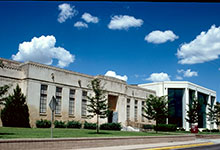
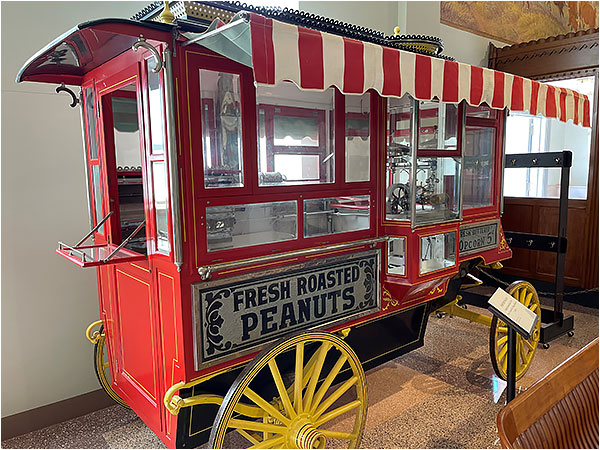
Popcorn Wagon
Originally purchased May 19, 1915 from C. Cretors & Co., Chicago, Illinois for $1,045

Bugbee Murals
Harold Dow Bugbee painted the murals on the north, south, and east walls of Pioneer Hall. He served as the Museum Curator of Art from 1951 until his death in 1963. Bugbee usually painted western scenes and illustrated many books with his pen and ink drawings. Bugbee made all but one of the sketches reproduced as large banners on the north wall. His wife, artists Olive Vandruff, drew the oil derrick. Under President Roosevelt’s New Deal, Ben Carlton Mead painted two murals on the west wall of Pioneer Hall: Untitled (Antelope Creek People) and Coronado’s Coming. A third mural for the west wall, Comancheros, was installed in 1957. A student of Western history, Mead also painted smaller works and illustrated numerous publications about the West.
Harold Dow Bugbee, Hide Hunters, 1956
Harold Dow Bugbee, The Cattleman, 1934
Harold Dow Bugbee, Ranch Headquarters, 1940
Ben Carlton Mead, Untitled [Antelope Creek People], 1940
Ben Carlton Mead, Coronado’s Coming, 1934
Ben Carlton Mead, Comancheros, 1957
Harold Dow Bugbee, Kiowa Hunting Buffalo, 1957
Harold Dow Bugbee, Working Cattle on the Open Range, 1958
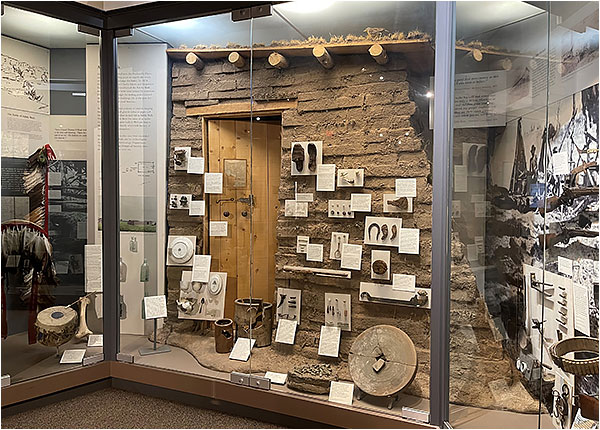
Adobe Walls Display
As hide hunters moved into the Panhandle-Plains, merchants built trading posts to supply the needs of the hunters in exchange for hides. In 1874, Dodge City merchant Charlie Myers and his partner Frederick J. Leonard established the Adobe Walls trading post, and they were soon joined by the merchant Charles Rath. Although the trading post consisted of five picket and sod buildings, life at the post did have its comforts and small luxuries. Archeologists discovered a variety of objects, ranging from china and etched glass to tobacco pipes and beer bottles, that offer clues to daily life at Adobe Walls. The post took its name from the ruins of an earlier nearby adobe trading post built by William Bent in 1843 and abandoned shortly afterwards because of hostile Kiowas and Comanches. Most of the artifacts in this case were excavated at the 1874 Adobe Walls site by archeologists from the Museum’s Archeology Department. The Panhandle-Plains Historical Society owns and maintains the five-acre site.
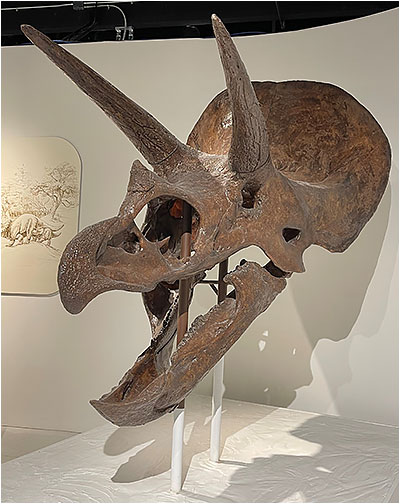
Triceratops Skull
Three-Horned Ceratopsian Dinosaur – Triceratops – Late Cretaceous, Western North America – Triceratops resembled a rhinoceros. Characterized by 3 horns and a bony frill at the back of the skull, the large, upland dwelling plant eater weighed 6 to 8 tons and measured about 25 feet in length.
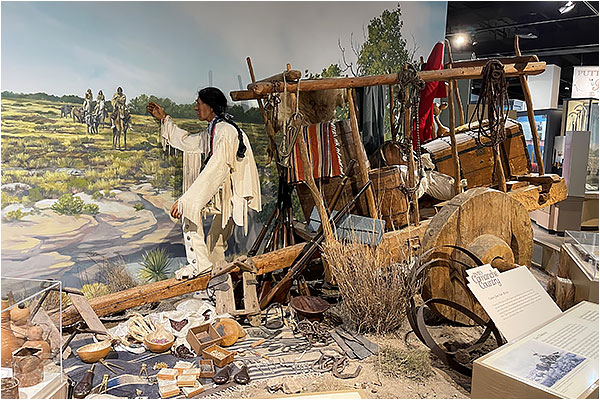
Comanche Wagon
Hispanic and Pueblo Indian bison hunters called ciboleros made trips into the Texas Panhandle probably as early as the 1600s. By the early 19th century, the size and importance of the bison hunts steadily increased. Ciboleros preferred to kill bison with lances or bows and arrows even after rifles were introduced into the region. The ciboleros returned to New Mexico from these hunts with their carretas (carts) piled high with dried meat and hides for trade. The Southern Plains Indians usually tolerated the ciboleros until the 1850s when the bison herds began to noticeably decline in number. During this time hostilities developed into a short but violent war between the ciboleros and the Cheyennes. However, the ciboleros continued to hunt in the Panhandle-Plains until the 1870s when the Euro-American bison hunters armed with repeating rifles wiped out the herds.
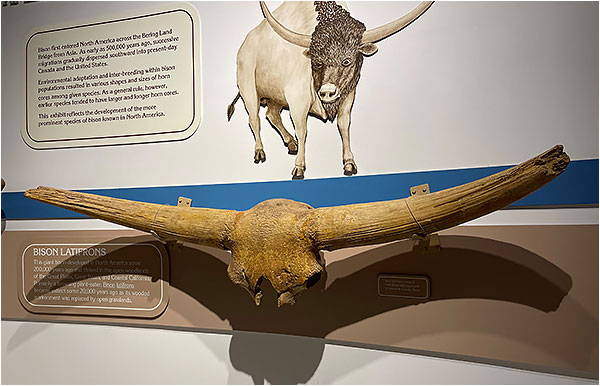
North American Bison Skull
Bison Latifrons – This giant bison developed in North America some 200,000 years ago and thrived in the open woodlands of the Great Plains, Great Basin, and Coastal California. Primarily a browsing plant-eater, Bison latifrons became extinct some 20,000 years ago as its wooded environment was replaced by open grasslands.
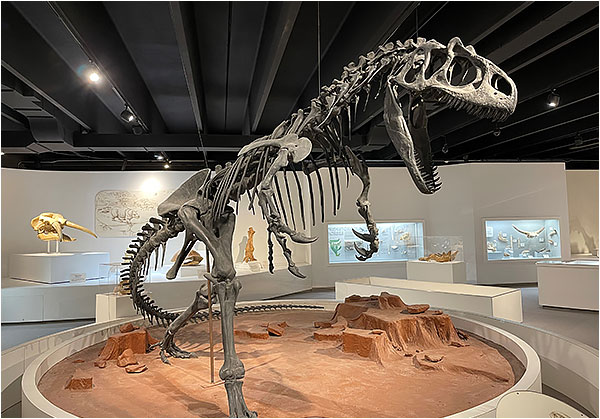
Allosaurus
Allosaurus (“Different reptile”) was one of the most dangerous and abundant meat-eating dinosaurs during the Late Jurassic Period. Standing about thirty feet tall, Allosaurus roamed the primitive, subtropical forests which covered western North America some 200 to 140 million years ago. A heavy tail counterbalanced the dinosaur’s large head and upper body, allowing it to move erect on swift and powerful hind legs. Armed with clawed forelimbs and long jaws studded with dagger-like teeth, this voracious predator killed and ate its fellow dinosaurs large and small.

Palo Duro Canyon Replica
Formation of The Palo Duro Canyon – The colorful, layered escarpments of Palo Duro Canyon reveal 280 million years of geologic history. As landforms go, the Palo Duro is comparatively young. Only about a million years ago streams began cutting into the level plains of the Texas Panhandle. Once the waters had eaten through the protective, caliche caprock, erosion and wasting scoured a channel and carried off the softer material beneath. This continuing phenomenon constantly deepens and widens the canyon formation.
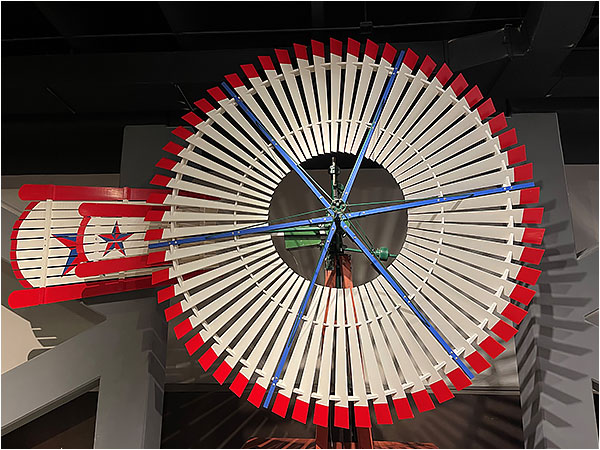
Original Star Windmill
The Original Star was second in popularity only to the Eclipse windmills on the Southern Great Plains in the late nineteenth and early twentieth centuries. Made by the Flint and Walling Manufacturing Company of Kendallville, Indiana, from 1878 to 1915, they were sold in sizes ranging from ten to twenty-six feet in diameter. For many years the beautiful red, white, and blue mills were a common element in the plains landscape. The ten-foot size represented here by a restored example, sold for $90.00 in 1887.
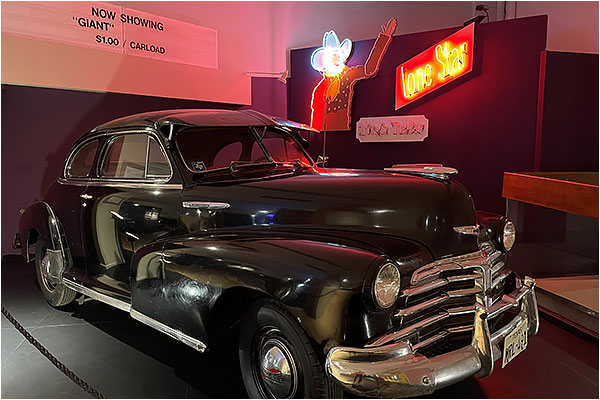
Chevrolet Club Coupe
Well-known Panhandle artist Harold D. Bugbee (1900-1963), who lived at Clarendon, Texas and served as the first curator of art at Panhandle-Plains Historical Museum from 1951 until 1963, owned this 1948 Chevrolet Club Coupe. Bugbee purchased the car new and maintained it in excellent shape even though he used it as his “painting car” when he went out into the country to sketch and paint. The Chevrolet retains its original black exterior finish as well as its original interior upholstery. A motion picture drive-in still in operation today at Clarendon is located across the highway from the 3-B Bugbee Ranch, so Harold may have used the car sometime to attend movies.
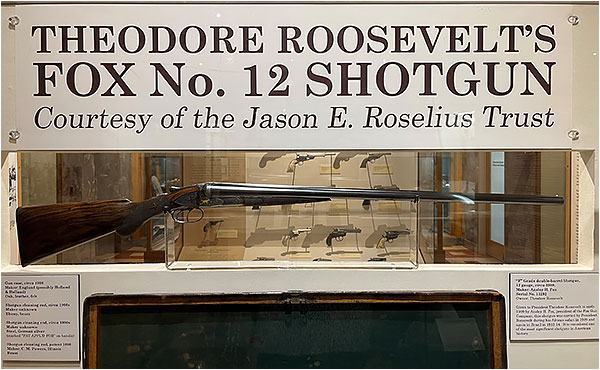
Roosevelt’s Shotgun
“F” Grade double-barrel Shotgun,
12 gauge, circa 1909.
Maker: Ansley H. Fox
Serial No. 13292
Owner: Theodore Roosevelt
On Loan from the Jason Roselius Trust
Given to President Theodore Roosevelt in early 1909 by Ansley H. Fox, president of the Fox Gun Company, this shotgun was carried by President Roosevelt during his African safari in 1909 and again in Brazil in 1913-14. It is considered one of the most significant shotguns in American history.
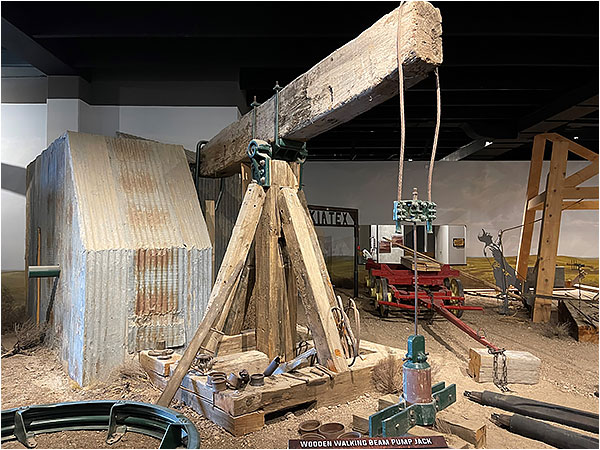
Pumpjack
Wooden Walking Beam Pump Jack
Drilling a well is just the first step in producing oil or gas. Wells that lack sufficient natural pressure to cause them to flow require pumping. Today, a variety of pumping methods are available, but in the early days of the industry, the same steam-driven walking beam used for drilling also served as a pump jack.

Electric Car
1916 Detroit Electric Model 66 Brougham – Priced at $2275 (approximately $38,500 in today’s money), the approximate cost of nine Model T. Ford automobiles at the time, the Detroit Electric was an upper class means of transportation. Forty-two batteries, half in front and half in the rear of the car, powered the vehicle which had a top speed of 21 miles per hour and would run 65-100 miles before the batteries had to be recharged. The five-passenger car can be operated-steered, accelerated, and stopped-from the front or rear seats and its transmission has five forward and five reverse gears. Detroit Electric cars were manufactured by the Anderson Carriage Company of Detroit form 1907 until 1910, by the Anderson Electric Car Company of Detroit from 1911 until 1918, and by the Detroit Electric Car Company of Detroit from 1919 until 1938.
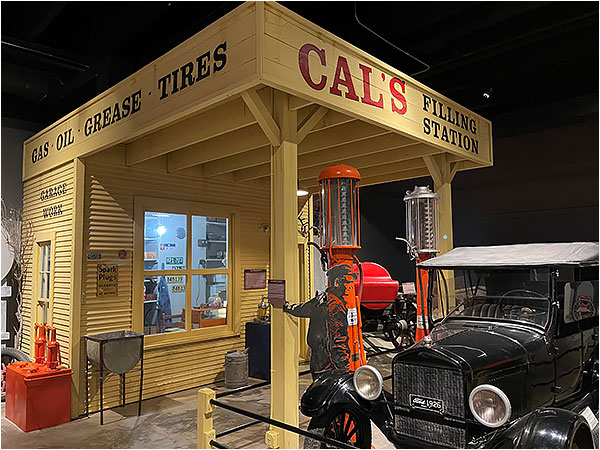
Petroleum Story
The filling Station was the final step in delivering most petroleum products to the consumer. In many localities, the station represented far more than just a retail outlet for fuel. It often doubled as a country store where groups gathered for coffee and conversation, not to mention games of dominoes and cards, and entertainment from the radio. Here one could find not only gasoline for cars and tractors, kerosene for heating and lighting, and white gas for washing machine engines, but also fresh eggs, cold soda pop, water for radiators, and a telephone for urgent calls. Here, too, travelers stopped for directions and road information. Serving so many purposes, the filling station was at the center of community life.
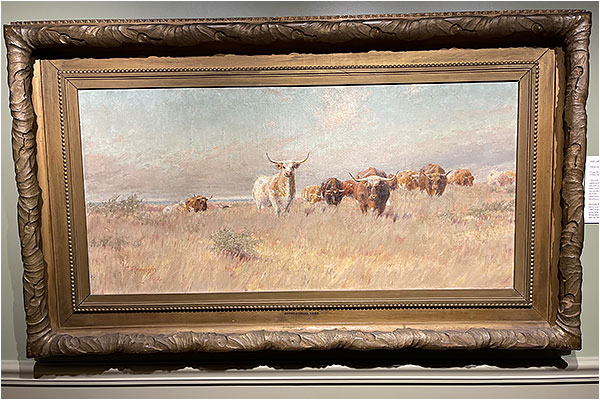
Reaugh Approaching Herd
The Approaching Herd, 1902
Oil on canvas mounted on board
Frank Reaugh Estate
“An early day herd of long-horn Texas cattle… These cattle on the ‘point’ were splendid specimens, five or six years old… They were beautiful animals… They were very wild. Many of them had never seen a man on foot before. People walking were sometimes treed by them. It would’ve happened oftener if there had been more trees.” Frank Reaugh, Paintings of the Southwest, 1937.
Probably Reaugh’s masterpiece, The Approaching Herd, was exhibited at the Art Institute of Chicago in 1903, with the Society of Western Artists in 1903, and at the State Fair of Texas in 1905, and hung in the White House office of President George W. Bush from 2001 to 2008.
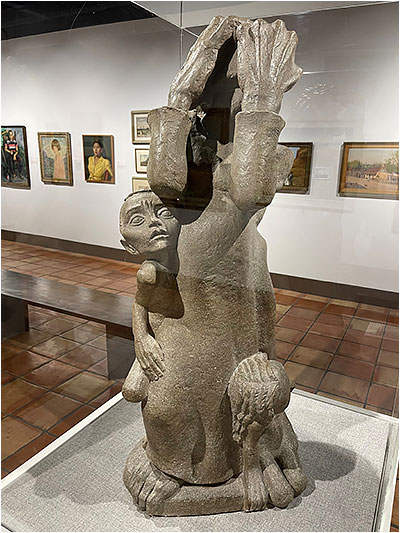
Charles Umlauf (1911-1994)
Refugees, 1939
Painted Palster
Purchase funded by Dr. and Mrs. Douglass Hyde
Born in Michigan to German immigrant parents, Umlauf studied at the Chicago School of Sculpture and the Art Institute of Chicago with Albin Polasek in 1929. About 1932 Umlauf became an assistant to famed Chicago sculptor, Lorado Taft. Returning to the AIC until 1937, Umlauf then sculpted for the Works Progress Administration’s Federal Art Project. About this time Umlauf created Refugees as his own commentary on the effects of World War II on civilians. He moved to Austin in 1941 where he taught for 40 years in the new art department of the University of Texas. His sculptures are to be found in public collections across the United States, including the Museum of Fine Arts, Houston; the Witte Museum; Dallas Museum of Art; the Smithsonian Institution; and the Metropolitan Museum of Art. In 1985 he gave his home and studio to the city of Austin to create the Umlauf Sculpture Garden and Museum.
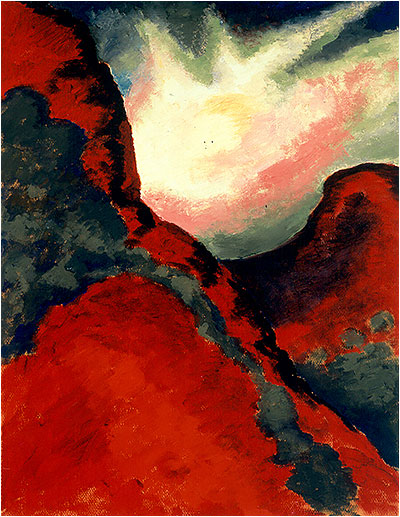
Red Landscape
Oil on board
Gift of The Georgia O’Keeffe Foundation
Born at Sun Prairie, Wisconsin, Georgia O’Keeffe first learned of the West through stories read to her by her mother. Following studies at the Art Institute of Chicago and the Art Students League at New York, she worked as a commercial artist in Chicago. O’Keeffe was supervisor of drawing and penmanship for Amarillo schools from 1912 to 1914, but returned to New York to study with Arthur Wesley Dow, a leading teacher of Modernism, at Columbia Teachers College. She taught at Columbia College in Columbia, South Carolina in 1915, then in September 1916 O’Keeffe began teaching at West Texas State Normal College in Canyon. During the 1918 influenza epidemic, she took sick leave to recuperate on a friend’s’ ranch near Waring, Texas. Later that year she resigned from the College and moved to New York. While in Canyon, O’Keeffe spent her free time painting and drawing Palo Duro Canyon, the flatness of the plains, and the great dome of sky. Experts on the artist consider her time in Canyon essential to her becoming one of the most important American artists of the twentieth century. O’Keeffe herself acknowledged the Texas Plains as her spiritual home. O’Keeffe boarded in at least three places while in Canyon, two of which residences are private homes not open to visitors. The Hudspeth House is now a bed and breakfast inn and welcomes visitors. O’Keeffe taught in “Old Main,” the present administration building for West Texas State University. Only four oil paintings resulted from O’Keeffe’s time in Canyon, including Red Landscape. The Museum is fortunate to have such an extremely rare example of O’Keeffe’s work on the Texas Plains.
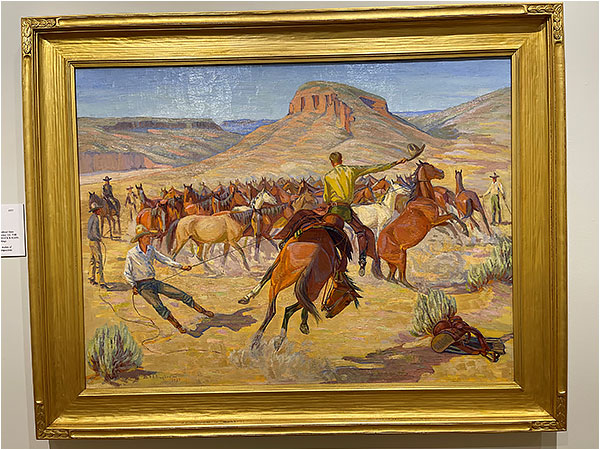
The Rope Corral Bugbee
The Rope Corral, 1927
Oil on canvas
H.D. Bugbee Estate
During the late 1920s and 1930s, Bugbee exhibited three major paintings as a kind of “triptych” of cowboy life: THE ROPE CORRAL, BRANDING, and THE CHUCKWAGON. Panhandle-Plains owns two of the three paintings. Bugbee constructed this painting using both studies of different parts and sketches of the overall composition.
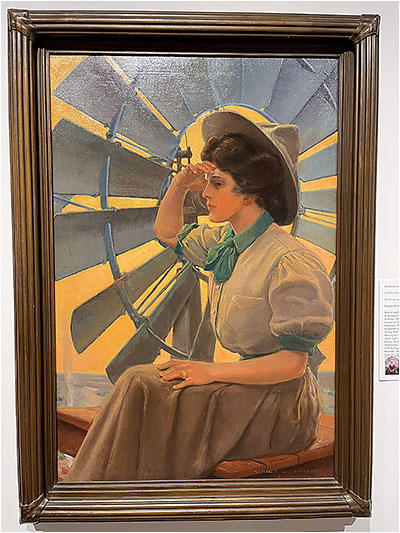
Madonna of the Windmill
Remington Schuyler (1884-1955)
Untitled [Madonna of the Windmill] circa 1915
Oil on canvas
Bugbee-Reaugh Acquisition Fund
Born in Buffalo, New York, Schuyler studied art at Washington University in St. Louis, the American Academy in Rome, the Academie Julian in Paris, the Art Students League in New York, and with Howard Pyle at Wilmington, Delaware. Pyle helped him secure illustration work for magazines such as The Saturday evening Post by 1906. During World War I, Schuyler designed camouflage for ships. Moving to Connecticut in the late 1920s, he illustrated for “pulp” and “slick” magazine such as Wild West, Frontier Stories, St Nicholas and The Century. During the Depression, Schuyler painted murals under the New Deal. In 1948 he began teaching art at Missouri Valley College in Marshall, Missouri. This painting is a variation of W. H. D. Koerner’s Madonna of the Prairie.
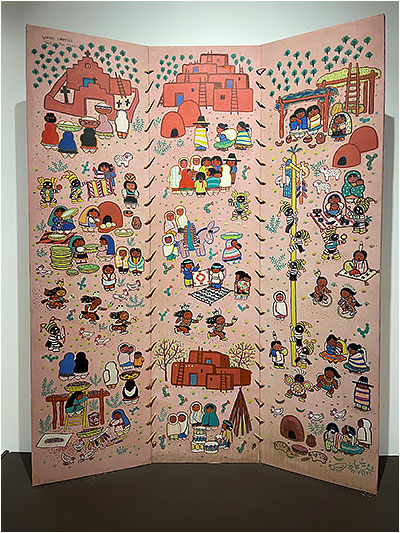
Gisella Pink Triptych
Gisella Loeffler (1903 Austria-1977 USA)
Untitled Triptych [Taos Pueblo Scenes] circa 1940
Oil on canvas
Frank Chase Estate
This folding screen was the centerpiece in Gisella’s home for many years. It was recently restored in the Museum’s Conservation Center.
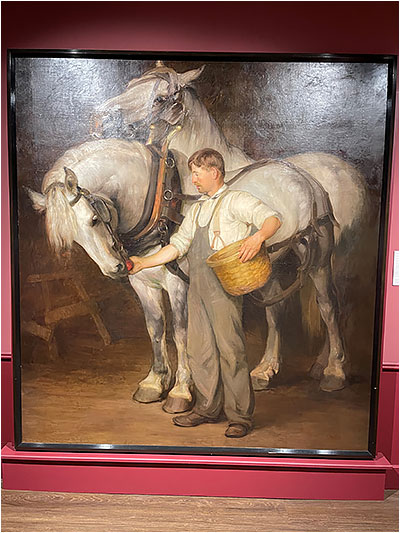
Lockman’s Partiality
DeWitt McClellan Lockman (1870-1957), American
Partiality, 1905
Oil on canvas
Gift of Mrs. DeWitt M. Lockman
Born in Brooklyn, Lockman began painting at age four and exhibiting at the National Academy of Design in 1880. He studied in Paris and in the Netherlands. Although Lockman focused on portraiture, for his genre paintings he sketched farm buildings, animals, and local people near his family’s estate at Windham, Connecticut. Elected to the National Academy in 1919, he exhibited widely, receiving numerous accolades. Lockman’s works are held by the Metropolitan Museum of Art; the National Academy of Design, the New-York Historical Society; the Pennsylvania Academy of the Fine Arts; the United States Military Academy; and Yale University. Among Lockman’s sitters were Presidents Calvin Coolidge and Franklin D. Roosevelt. Dr. William H. Gerdts, Professor Emeritus of Art History, University of New York, recently discovered the correct title for this painting and that Lockman exhibited Partiality at the National Academy of Design in 1906.
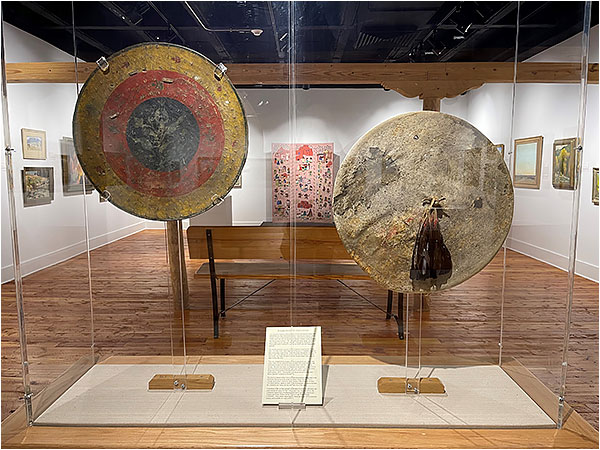
Spanish-Comanche Hybrid Shields
This Spanish-Comanche shield and cover are the oldest known artifacts that demonstrate the close relationship between Comanche and Spanish cultures. Research in the La Mancha district of Spain, particularly in and around Toledo, shows the style and motif of the Spanish “rondela” (round shield) to date back to approximately 1780. The particular thistle design, which is still quite evident, was not used past 1780-86. Although the design motif featuring the thistle continued to be used, the actual style was changed after that time.
The shield is probably numerous layers of goat skin laced together one at a time. The outer cover, which came into being once in Comanche hands, has been tested and is indeed bison. Notice the pucker through the middle of the shield cover. This indicates the cover is made from the hump portion of a male bison. The straps on back to hold a shield probably came from the same bison as the cover.
There are vestigial simple designs colored in natural red and yellow ocher pants. There are two projectile holes, probably from single ball shot, that punctured both the cover and the hard inner shield with blood staining present. Samples were taken, but the analysis has not been completed as to the DNA features of the blood type. The other shield is classic Comanche design and craftsmanship of the period prior to forced captivity (approximately 1875). Consequently, the shield and cover is the oldest known Spanish-Comanche hybrid artifact
The shield is reputed to have been a battlefield acquisition dating back to the Red River War. In the locale of Yellow House Canyon. This is virtually all we know. However, more forensic work remains to be done. Few classic artifacts speak as clearly to the hybridization of cultures between the Comanche and Spain, and the important role of the horse.
Acquisition of this artifact required cooperation of numerous individuals and organizations including William Voelker and Troy, directors of SIA, the Comanche Nation Ethno-Ornithological Initiative; and Julie Puckett and Virginia and Chope Phillips for the Genevieve and Waite Phillips Foundation. These efforts ensure that the shield and cover will be protected, curated, and available for study at PPHM.
 Autorotate
Autorotate Help
Help Maps
Maps Gyro
Gyro Share
Share VR Headset
VR Headset
